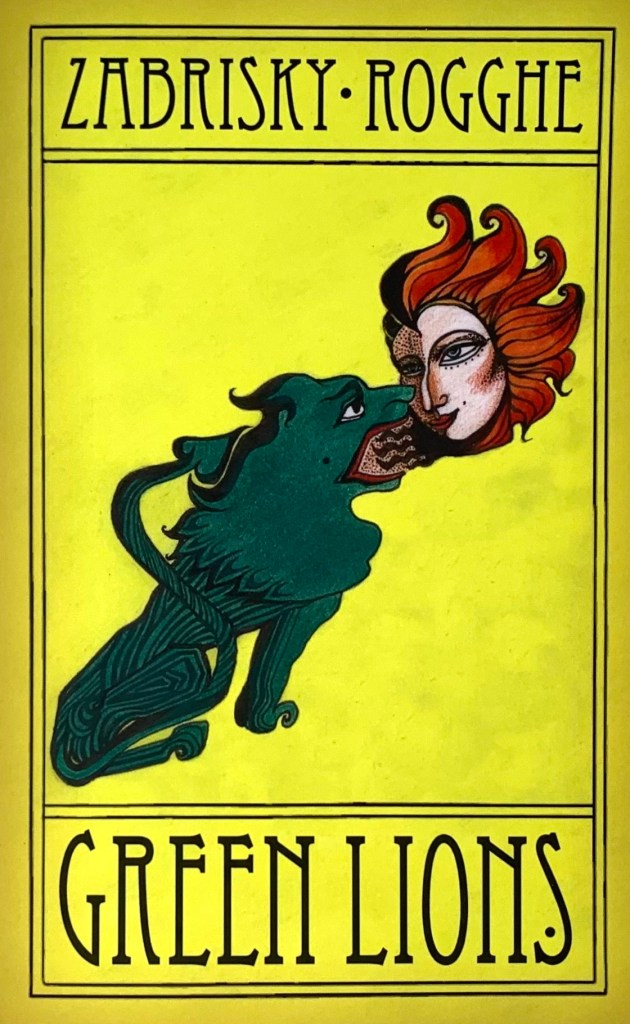TITLE: Green Lions
AUTHORS: Zarina Zabrisky and Simon Rogghe
GENRE: Poetry duet
PUBLISHER: Vox Nova
PROCUREMENT: author
REVIEWER’S RELATIONSHIP TO AUTHOR: none
*Guest reviewed by reader Kim Koga
When I started reading this book I felt quite unprepared and almost uncomfortable because I didn’t know what I was reading or how to access it, but I kept on reading in hopes of some kind of reveal. However, a few poems in I realized that that wouldn’t happen. As my eyes scanned the letters I could feel my brain resisting the images, the words, the sounds, and I wasn’t sure how to break my mind open. After reading a few more poems I returned to the dedication: André Breton; and I began to look towards the surrealists. I skimmed the Surrealist Manifesto again and read about Breton and the surrealists. I read on alchemy and picked up a tarot kit to review the major arcana and history of tarot. After all of this I turned back to Green Lions better prepared and was able to give myself over to the images, allowing them to melt through my mind rather than resisting them.
When my brain was able to melt through the images and words and sounds and lines, I entered into the dreamlike landscape of the poems. By dreamlike I do not mean a kind of whimsy or cuteness, or white-fluffy-cloud dreaminess, but more so the dreams of Salvador Dalí and the colors of Joan Miró, all mixed in with alchemy and the tarot’s leaky medium for divining, fortune telling, and advice seeking. The first four sections of the book are named after the elements: water, fire, air, earth. These culminate in the last section titled Ether.
In alchemy the green lion devouring the sun is a symbol for sulphuric acid, nitric acid, or hydrochloric acid and its ability to dissolve even ‘the most noble material’—gold. In other words, the green lion signifies a step in the metallurgic transformation process. Each step or transformation is symbolized by an animal (in sequence): black crow, white swan/eagle, green lion, peacock’s tail, unicorn, pelican feeding its young with blood/rooster, phoenix. The transformations in this book hold at the acidic melting point. Images are at once formed and melting, and then transformed and melting, which reminded me of Dalí’s paintings.
Green Lions is derived from a transformation to gold but fails in between. Instead of completing the transformation, the book stalls at the green lion. But because it stalls at the green lion, doesn’t mean that the book stops tumbling into future transformations when the reader closes the cover; rather it keeps transforming with each transmutation and transformation spawning a little genetic twist here and mutation there. However, when the book is picked up again the reader is snapped back to melting/devouring green lion.
These poems are not limited to poetry, nor drawings limited to visual art. I think that Green Lionsbest functions in bleeding across art forms: poems become a play, become a short story, a fiction, a dream, a drawing, a live action, a still life, an installation, etc. The language(s) and fonts create the voices of Zabrisky and Rogghe as lovers, as fishes and snakes, the headless Star card pouring out her heart waters, the Magician – each poem and each drawing mutates into something new and creates a synesthetic experience. To read these poems as poem is a mistake in that the reader’s mind is trapped by genre and other limiting definitions. To read these poems as words that are creating something other than words opens up the entire work to new angles and meanings, which is the way I think that this work was intended: a hugely multifaceted, multigenred piece of art. The words exist as a buoy in the ocean that moves with the swell continuously but never reaches a shore, thus it is and always will be moving slowly and rhythmically.
The illustrations in the book do not give anything away, but rather add to the complexity of the poems as they stretch across the tarot, alchemy, and surreal imagery. Some of the illustrations are clearly derived from specific tarot cards, but most of them are of a more muddy origin, and feel like they were created from the idea of tarot and the idea of alchemy rather than a direct correlation. Zabrisky’s and Rogghe’s poems create a dialogue between two people/characters as they engage with this morphic world of the green lion.
The language is elastic and filled with multiple meanings, undulating imagery, and the dual voices of Rogghe and Zabrisky. They are also conscious of origin and inspiration recalling Breton, Brancusi, and Magritte with a poem titled “Equestrian Seduction Duet (This Poem Is Not About Horses).” Many of the poems are duets that play out like conversations adding to the idea of performativity and theatre. The writing itself feels spontaneous and is filled with dreamlike imagery but remains highly conscious of itself with multiple poems referring to poems or poetry. At first the self-reference was somewhat irritating, but then I think that these poems and this book are investigations into literature and art. Investigations into surrealism, performance, and theatre.
Although Green Lions feels rather unfinished to me, I do not think that there could be any way to neatly wrap up an investigation into art. Rather, I feel that this book is more of a jumping off point into the depths of collaborative and limitless art forms.
*Kim Koga is a writer and editor. Her work has been published in _list, 1913, Lantern Review. and Ariel. Tinfish Press published her chapbook Ligature Strain in 2011. She currently resides in San Diego, CA.


[…] the last several years, and I am truly entranced by her work, both in fiction and as an activist, poet, and performer. Zabrisky was kind enough to answer my questions […]
LikeLike